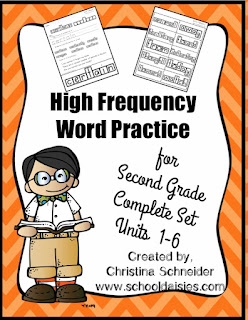Have you ever felt crunched with time during your language arts block and thought, do I really need to review the sight words with my class? Can't I just pass out a list of words and hope for the best?
Here are the top things to know about sight words.
#1 Sight words are also called High Frequency Words. They appear not only in the written language but are most frequently used in spoken language as well. Therefore, by the time a child is school age he has these words in his verbal vocabulary and only needs to make the connection with its print version.
#2 The top 300 sight words make up about 2/3 of the written language. Think about that. If a child is able to recognize 300 sight words he is 2/3 of the way there to becoming a fluent reader.
#3 Some sight words can be sounded out because they are phonetically regular where others can not and must be memorized as a whole. Of course there are those sight words that half your class will read and say E-A-S-Y (at, on, it) but then we throw in those irregular ones like should, though, know and it is suddenly clear why we spend time practicing our sight words.
#4 Recognition of sight words leads to better comprehension. An advanced reader will read words as a whole. Try reading this sentence right here but pausing in between each letter and word. You need to read that several times for it to make sense. Now try reading an entire article or chapter in that broken manner.
#5 Word Walls are helpful. Whether you think you have the wall space or not, a primary classroom needs to have a word wall. I can't tell you how often my students refer back to this word wall during their writing throughout all subject areas. Isn't that what we want them to do?!
#6 Sight words make a great center activity. You don't have to spend direct instruction time every day going over the sight words. You can work them into a center activity and the students will get their daily practice with the words. I can't tell you how many weeks I need a quick NO PREP word center and quickly put out the week's sight word cards to be put in alphabetical order.
My advanced students will take it a step further and use their sight words in a sentence.
I've also developed these High Frequency Word Practice materials which follow the McGraw-Hill Wonders reading program for second grade.
At the start of the week I hand them a packet containing all the practice pages for their weekly words (10 words).
The students practice their sight words by tracing, writing, and reading them in a sentence. Then they cut out the word card on the bottom of the page to practice throughout the week.
We store them in our homework folders in these plastic pencil cases that I found "el cheapo" for 40 cents each.
The school year is about to start so here is a
Freebie of the first set of words to begin the year. I also have the complete set of units 1-6 in my TpT store.

















































